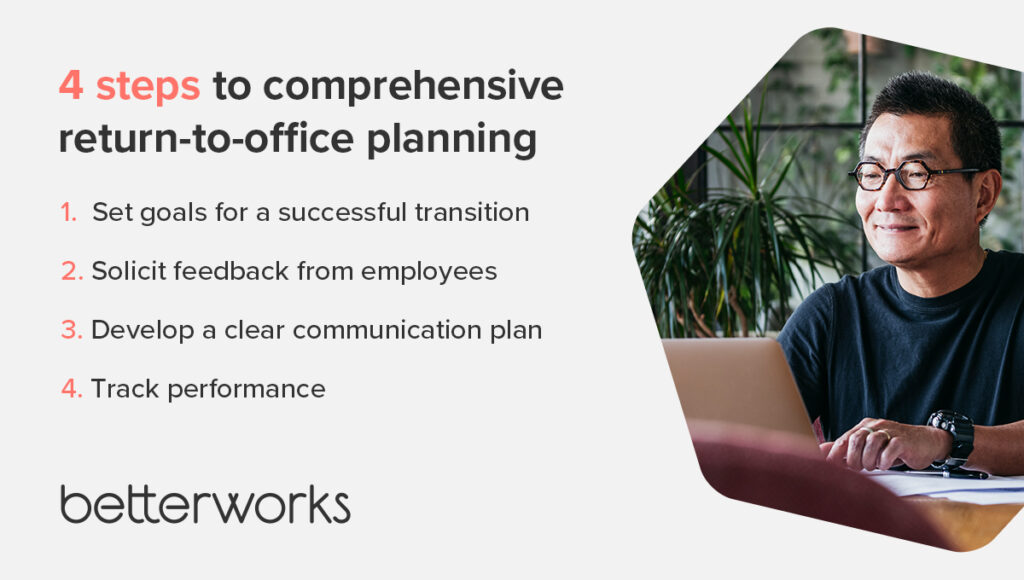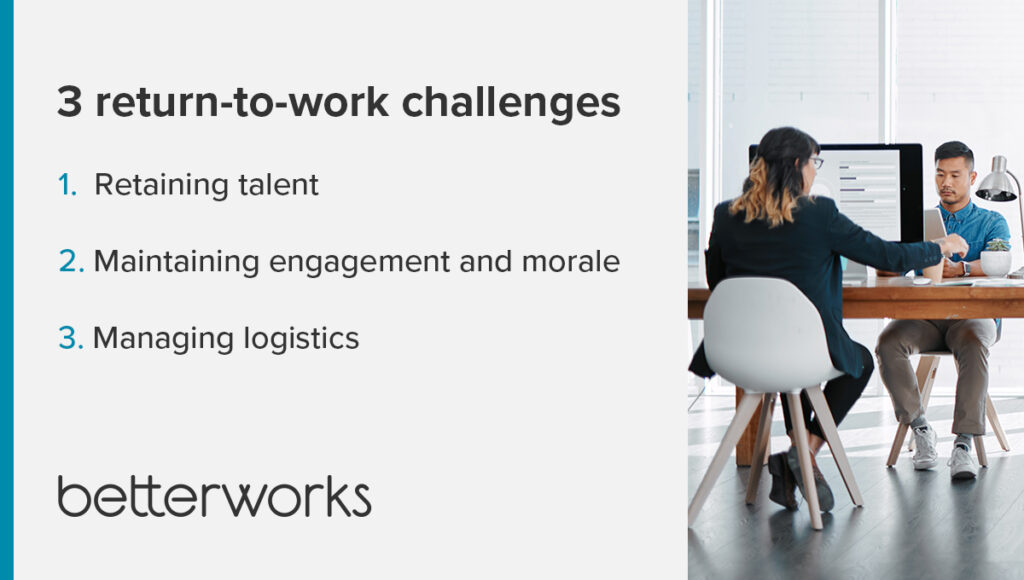After a few years of widespread remote and hybrid work, some large companies — including UPS, Boeing, and JPMorgan Chase — are making some or all employees return to work at the office.
For many employees, return-to-work plans are an unwelcome obligation that complicates their lives and routines. It’s up to HR to lead challenging discussions while helping employees adjust.
Learn how to plan for a return to work, how to address challenges, and why the right leadership practices and resources can help.
4 steps to comprehensive return-to-office planning
Embarking on a successful return to the office requires thoughtful planning and execution. Learn how to navigate the transition while emphasizing employee well-being, satisfaction, and a positive work environment.
Set goals for a successful transition
Before changing policy, you need to define what a successful transition looks like. Set goals that are specific, measurable, and realistic — and align with your strategic objectives. For example, you’ll likely measure changes in employee experience, engagement, satisfaction, and performance. Bear in mind that productivity may decline for a time. Studies have shown that employees are more productive at home.
Employee retention is a critical metric to track when moving employees back to job sites. Track retention rates before, during, and after the transition. Use exit interviews to understand the reasons behind employee departures, including whether the policy change contributed.
Solicit feedback from employees
Engage in transparent communication with employees about the return to the office. Consider your workforce’s diverse needs and circumstances, including people with underlying health conditions, caregiving responsibilities, or transportation challenges.
Flexibility is still important. “Remain open to employees’ needs as they restructure their days, such as late start times or early leave times for dropping off and picking up kids from school,” says organizational psychologist and Betterworks Program Strategy Director Caitlin Collins. “Ease employees back into working from the office gradually, starting with a few days a week.”
Use surveys and individual discussions to understand their preferences and concerns. Uncover engagement signals that could point to trouble. For example, says Caitlin, create a one-question survey to gauge sentiment and teach managers what signals to look out for that may indicate an employee is having trouble with the return-to-office transition.
Offer resources to help employees during the transition, including mental health support, tailored work arrangements, and transportation assistance. A gradual transition can help families that need to rearrange child care, for example.
“Remain open to employees’ needs as they restructure their days, such as late start times or early leave times for dropping off and picking up kids from school. Ease employees back into working from the office gradually, starting with a few days a week.”
caitlin collins, program strategy director, betterworks
Develop a clear communication plan
Clearly communicate the company’s plan for returning to the office, including any related changes to policies and procedures. Make sure you specify when and how often you expect employees to be in the office, especially if the policy is more or less restrictive for certain employee populations.
Beyond the policy details, explain the rationale behind the return-to-office mandate and suggest ways the change can benefit employees. Provide regular updates during the transition period while addressing concerns and making adjustments as needed.
Track performance
Using the goals you’ve established, decide which metrics you’re tracking, how often you’ll review them, and what findings could trigger a review or change in policy. Use data visualization tools, such as Betterworks analytics and insights, to make it easier to interpret and communicate findings. If certain metrics indicate challenges or dissatisfaction, be ready to make adjustments, or at least revisit communication strategies.
By continuously tracking metrics and adapting based on insights, you can adopt an agile and responsive approach to returning to the office. Even if some employees remain unhappy about the switch, they might appreciate the care and effort you put into it.

3 return-to-work challenges and how to address them
Here are a few challenges HR leaders might encounter when transitioning remote and hybrid workers to in-person work arrangements.
Retaining talent
Retention is always a risk when switching from remote or hybrid models. Many employees have become accustomed to the flexibility and autonomy that remote work often offers. This is especially true for any employees who were hired as remote or hybrid workers, as this is all new to them, at least within your organization.
You could be at risk of losing employees who can find other remote or hybrid job opportunities, especially if they feel you’re not meeting their needs. Stay competitive by reevaluating your compensation, benefits, career development opportunities, culture, and work-life balance.
Highlight the advantages of working for your organization that are boosted by in-person work. Additionally, make sure employees are aware of any programs that can help them manage the change, such as on-site child care or transportation assistance.
Maintaining engagement and morale
Shifting to in-office work can impact employee engagement and morale, especially for workers who prefer or have adapted to remote or hybrid work. Your policy change might be non-negotiable, but you can still be transparent and empathetic in addressing concerns and resistance. When employees don’t feel heard, they’ll become more dissatisfied. This could harm their productivity and lead them to air their complaints to co-workers, bringing morale down further.
Above all, employees want to feel heard, respected, and cared for. It’s always wise to adopt a flexible approach for accommodating individual needs and considering whether a particular role requires or benefits from an employee to be present in the office all or part of the time.
“If an organization is making the shift back to in-office work, it’s important that the organization lead with empathy and flexibility. Sustaining employee engagement lies in the ability to listen and respond to the unique needs of each employee.”
To motivate employees, roll out messaging highlighting the benefits of in-person work, such as opportunities for face-to-face collaboration, spontaneous interactions, and real-time problem-solving that contribute to team cohesion and innovation. Communicate how in-person work can improve their visibility within the company, create networking and mentorship opportunities, and otherwise be good for their careers. You might also highlight the positive impact of in-person interactions on employee well-being and mental health.
“If an organization is making the shift back to in-office work, it’s important that the organization lead with empathy and flexibility. Sustaining employee engagement lies in the ability to listen and respond to the unique needs of each employee.”
caitlin collins, program strategy director, betterworks
Managing logistics
Remote employees moving back to the office might understandably be concerned about their workspace and technology setup. Make sure your facilities have the necessary technology and connectivity infrastructure in place. Additionally, make sure you have sufficient equipment and IT staffing to support the sudden influx of office workers. This includes having enough desks and chairs to accommodate all employees, as well as space for meetings, phone calls, or focused work.
Coordinating schedules and managing employee rotations can be complex when transitioning from remote or hybrid work models to in-person, especially with limited office space. If you’re moving from fully remote to hybrid, use scheduling tools or software to coordinate in-office days and ensure everyone will have a workspace available.

The role of business leaders in returning to the workplace
Business leaders are calling remote and hybrid workers back to the office, so they’re also responsible for making the transition go smoothly. They must simultaneously focus on employee well-being and organizational productivity and effectiveness. This process starts with setting clear goals, communicating the transition plan, and promoting an inclusive and supportive work environment.
Additionally, leaders must champion open communication, address employee concerns, and adapt policies to accommodate evolving circumstances. Disruptive changes aren’t easy, but the right leadership support can help workers get through to the other side.
Use technology to streamline your return to office
Technology, exemplified by platforms like Betterworks, can streamline the return-to-office process by offering comprehensive solutions for communication, goal alignment, and performance management.
Betterworks provides tools to set, track, and align individual and team goals, enabling business leaders to communicate expectations clearly and track progress transparently. Additionally, features like continuous feedback and performance reviews foster a collaborative work environment. This contributes to a smooth return-to-office transition by improving communication, engagement, and productivity. It also ensures equitable access to performance-related activities regardless of whether an employee is in the office, hybrid, or fully remote. Using these tools can foster a level playing field with a workforce that may have a mix of work arrangements.
By prioritizing employee well-being, open dialogue, and innovative technology, you can navigate the return to work and set sail for a brighter future.
Want to learn more? Check out 10 core HR challenges in 2024.
HR: Are you ready to address what’s coming in 2024?






